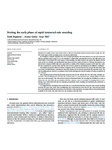Probing the early phase of rapid instructed rule encoding
| dc.contributor.author | Bugmann, Guido | |
| dc.contributor.author | Goslin, Jeremy | |
| dc.contributor.author | Thill, Serge | |
| dc.date.accessioned | 2019-11-12T16:27:26Z | |
| dc.date.issued | 2019-09-09 | |
| dc.identifier.issn | 0303-2647 | |
| dc.identifier.issn | 1872-8324 | |
| dc.identifier.other | 103993 | |
| dc.identifier.uri | http://hdl.handle.net/10026.1/15143 | |
| dc.description.abstract |
Humans can rapidly convert instructions about a rule into functional neural structures used to apply the rule. The early stages of this encoding process are poorly understood. We designed a stimulus-response (SR) task in which participants were first shown a SR rule on a screen for 200 ms, and then had to apply it to a test stimulus T, which either matched the S in the rule (SR trial) or not (catch trial). To investigate the early stages of rule encoding, the delay between the end of rule display and the onset of the test stimulus was manipulated and chosen between values of 50 ms to 1300 ms. Participants conducted three sessions of 288 trials each, separated by a median of 9 h. Random sequences of 20 rules were used. We then analysed the reaction times and the types of errors made by participants in the different conditions. The analysis of practice effects in session 1 suggests that the neural networks that process SR and catch trials are at least partially distinct, and improve separately during the practice of respectively SR and catch trials. The rule-encoding process, however, is common to both tasks and improves with the number of trials, irrespective of the trial type. Rule encoding shows interesting dynamic properties that last for 500 ms after the end of the stimulus presentation. The encoding process increases the response time in a non-stochastic way, simply adding a reaction time cost to all responses. The rule-retrieval system is functional before the encoding has stabilized, as early as 50 ms after the end of SR rule presentation, with low response errors. It is sensitive to masking however, producing errors with brief (100 ms) test stimulus presentations. Once encoding has stabilized, the sensitivity to masking disappears. It is suggested that participants do encode rules as a parametrized function, using the same neural encoding structure for each trial, rather than reconfiguring their brain anew for each new SR rule. This structure would have been implemented from instructions received prior to the experiment, by using a library of neural functions available in the brain. The observed errors are consistent with this view. | |
| dc.format.extent | 103993-103993 | |
| dc.format.medium | Print-Electronic | |
| dc.language | en | |
| dc.language.iso | en | |
| dc.publisher | Elsevier BV | |
| dc.subject | Instruction-based learning | |
| dc.subject | RITL | |
| dc.subject | Response time analysis | |
| dc.subject | Error analysis | |
| dc.subject | Neural mechanisms | |
| dc.subject | Catch trials | |
| dc.subject | Practice effects | |
| dc.title | Probing the early phase of rapid instructed rule encoding | |
| dc.type | journal-article | |
| dc.type | Journal Article | |
| plymouth.author-url | https://www.webofscience.com/api/gateway?GWVersion=2&SrcApp=PARTNER_APP&SrcAuth=LinksAMR&KeyUT=WOS:000491611300007&DestLinkType=FullRecord&DestApp=ALL_WOS&UsrCustomerID=11bb513d99f797142bcfeffcc58ea008 | |
| plymouth.volume | 184 | |
| plymouth.publication-status | Published | |
| plymouth.journal | Biosystems | |
| dc.identifier.doi | 10.1016/j.biosystems.2019.103993 | |
| plymouth.organisational-group | /Plymouth | |
| plymouth.organisational-group | /Plymouth/Faculty of Health | |
| plymouth.organisational-group | /Plymouth/Faculty of Health/School of Psychology | |
| plymouth.organisational-group | /Plymouth/Faculty of Science and Engineering | |
| plymouth.organisational-group | /Plymouth/REF 2021 Researchers by UoA | |
| plymouth.organisational-group | /Plymouth/REF 2021 Researchers by UoA/UoA04 Psychology, Psychiatry and Neuroscience | |
| plymouth.organisational-group | /Plymouth/REF 2021 Researchers by UoA/UoA04 Psychology, Psychiatry and Neuroscience/UoA04 REF peer reviewers | |
| plymouth.organisational-group | /Plymouth/REF 2021 Researchers by UoA/UoA11 Computer Science and Informatics | |
| plymouth.organisational-group | /Plymouth/Research Groups | |
| plymouth.organisational-group | /Plymouth/Research Groups/Centre for Brain, Cognition and Behaviour (CBCB) | |
| plymouth.organisational-group | /Plymouth/Research Groups/Centre for Brain, Cognition and Behaviour (CBCB)/Brain | |
| plymouth.organisational-group | /Plymouth/Research Groups/Marine Institute | |
| plymouth.organisational-group | /Plymouth/Users by role | |
| plymouth.organisational-group | /Plymouth/Users by role/Academics | |
| dc.publisher.place | Ireland | |
| dcterms.dateAccepted | 2019-07-16 | |
| dc.rights.embargodate | 2020-9-8 | |
| dc.identifier.eissn | 1872-8324 | |
| dc.rights.embargoperiod | Not known | |
| rioxxterms.versionofrecord | 10.1016/j.biosystems.2019.103993 | |
| rioxxterms.licenseref.uri | http://www.rioxx.net/licenses/all-rights-reserved | |
| rioxxterms.licenseref.startdate | 2019-09-09 | |
| rioxxterms.type | Journal Article/Review |


